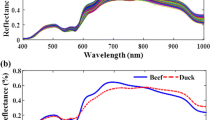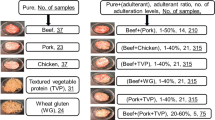Abstract
For the first time, a visible near-infrared (Vis-NIR) hyperspectral imaging system (400–1000 nm) was investigated for rapid and non-destructive detection of adulteration in minced beef meat. Minced beef meat samples were adulterated with horsemeat at levels ranging from 2 to 50 % (w/w), at approximately 2 % increments. Calibration model was developed and optimized using partial least-squares regression (PLSR) with internal full cross-validation and then validated by external validation using an independent validation set. Several spectral pre-treatment techniques including derivatives, standard normal variate (SNV), and multiplicative scatter correction (MSC) were applied to examine the influence of spectral variations for predicting adulteration in minced beef. The established PLSR models based on raw spectra had coefficients of determination (R 2) of 0.99, 0.99, and 0.98, and standard errors of 1.14, 1.56, and 2.23 % for calibration, cross-validation, and prediction, respectively. Four important wavelengths (515, 595, 650, and 880 nm) were selected using regression coefficients resulting from the best PLSR model. By using these important wavelengths, an image processing algorithm was developed to predict the adulteration level in each pixel in whole surface of the samples. The results demonstrate that hyperspectral imaging coupled with multivariate analysis can be successfully applied as a rapid screening technique for adulterate detection in minced meat.





Similar content being viewed by others
References
Alamprese, C., Casale, M., Sinelli, N., Lanteri, S., & Casiraghi, E. (2013). Detection of minced beef adulteration with turkey meat by UV–VIS, NIR and MIR spectroscopy. LWT - Food Science and Technology, 53, 225–232.
Al-Jowder, O., Defernez, M., Kemsley, E., & Wilson, R. H. (2002). Detection of adulteration in cooked meat products by mid-infrared spectroscopy. Journal of Agricultural and Food Chemistry, 50, 1325–1329.
Andrés, S., Silva, A., Soares-Pereira, A. L., Martins, C., Bruno-Soares, A. M., & Murray, I. (2008). The use of visible and near infrared reflectance spectroscopy to predict beef M. Longissimus thoracis et lumborum quality attributes. Meat Science, 78, 217–224.
Barbin, D., ElMasry, G., Sun, D.-W., & Allen, P. (2012a). Near-infrared hyperspectral imaging for grading and classification of pork. Meat Science, 90, 259–268.
Barbin, D., ElMasry, G., Sun, D.-W., & Allen, P. (2012b). Predicting quality and sensory attributes of pork using near-infrared hyperspectral imaging. Analytica Chimica Acta, 719, 30–42.
BBC. (2010). (http://news.bbc.co.uk/2/hi/asia-pacific/7720404.stm) (accessed: 13 June 2014).
Boyaci, I. H., Temiz, H. T., Uysal, R. S., Velioglu, H. M., Yadegari, R. J., & Rishkan, M. M. (2014). A novel method for discrimination of beef and horsemeat using raman spectroscopy. Food Chemistry, 148, 37–41.
Burger, J., & Gowen, A. (2011). Data handling in hyperspectral image analysis. Chemometrics and Intelligent Laboratory Systems, 108, 13–22.
Cozzolino, D., & Murray, I. (2004). Identification of animal meat muscles by visible and near infrared reflectance spectroscopy. LWT - Food Science and Technology, 37, 447–452.
Dissing, B. S., Papadopoulou, O. S., Tassou, C., Ersbøll, B. K., Carstensen, J. M., Panagou, E. Z., & Nychas, G.-J. (2013). Using multispectral imaging for spoilage detection of pork meat. Food and Bioprocess Technology, 6, 2268–2279.
Ellis, D. I., Brewster, V. L., Dunn, W. B., Allwood, J. W., Golovanov, A. P., & Goodacre, R. (2012). Fingerprinting food: current technologies for the detection of food adulteration and contamination. Chemical Society Reviews, 41, 5706–5727.
ElMasry, G., Sun, D.-W., & Allen, P. (2011). Non-destructive determination of water-holding capacity in fresh beef by using NIR hyperspectral imaging. Food Research International, 44, 2624–2633.
ElMasry, G., Kamruzzaman, M., Sun, D.-W., & Allen, P. (2012a). Principles and applications of hyperspectral imaging in quality evaluation of agro-food products, a review. Critical Reviews in Food Science and Nutrition, 52, 999–1023.
ElMasry, G., Sun, D.-W., & Allen, P. (2012b). Chemical-free assessment and mapping of major constituents in beef using hyperspectral imaging. Journal of Food Engineering, 117, 235–246.
Feng, Y.-Z., ElMasry, G., Sun, D.-W., Scannell, A. G. M., Walsh, D., & Morcy, N. (2013). Near-infrared hyperspectral imaging and partial least squares regression for rapid and reagentless determination of Enterobacteriaceae on chicken fillets. Food Chemistry, 138, 1829–1836.
Feng, Y.-Z., & Sun, D.-W. (2013). Near-infrared hyperspectral imaging in tandem with partial least squares regression and genetic algorithm for non-destructive determination and visualization of Pseudomonas loads in chicken fillets. Talanta, 109, 74–83.
Grau, R., Sánchez, A. J., Girón, J., Iborra, E., Fuentes, A., & Barat, J. M. (2011). Nondestructive assessment of freshness in packaged sliced chicken breasts using SW-NIR spectroscopy. Food Research International, 44, 331–337.
Iqbal, A., Sun, D.-W., & Allen, P. (2013). Prediction of moisture, color and pH in cooked, pre-sliced turkey hams by NIR hyperspectral imaging system. Journal of Food Engineering, 117, 42–51.
Kamruzzaman, M., ElMasry, G., Sun, D.-W., & Allen, P. (2011). Application of NIR hyperspectral imaging for discrimination of lamb muscles. Journal of Food Engineering, 104, 332–340.
Kamruzzaman, M., Barbin, D., ElMasry, G., Sun, D.-W., & Allen, P. (2012a). Potential of hyperspectral imaging and pattern recognition for categorization and authentication of red meat. Innovative Food Science & Emerging Technologies, 16, 316–325.
Kamruzzaman, M., ElMasry, G., Sun, D.-W., & Allen, P. (2012b). Prediction of some quality attributes of lamb meat using near infrared hyperspectral imaging and multivariate analysis. Analytica Chimica Acta, 714, 57–67.
Kamruzzaman, M., ElMasry, G., Sun, D.-W., & Allen, P. (2012c). Non-destructive prediction and visualization of chemical composition in lamb meat using NIR hyperspectral imaging and multivariate regression. Innovative Food Science and Emerging Technologies, 16, 218–226.
Kamruzzaman, M., Sun, D.-W., ElMasry, G., & Allen, P. (2013a). Fast detection and visualization of minced lamb meat adulteration using NIR hyperspectral imaging and multivariate image analysis. Talanta, 103, 130–136.
Kamruzzaman, M., ElMasry, G., Sun, D.-W., & Allen, P. (2013b). Non-destructive assessment of instrumental and sensory tenderness of lamb meat using NIR hyperspectral imaging. Food Chemistry, 141, 389–396.
Kamruzzaman, M., Makino, Y., & Oshita, S. (2015). Non-invasive analytical technology for the detection of contamination, adulteration, and authenticity of meat, poultry, and fish: A review. Analytica Chimica Acta, 853, 19–29.
Kelly, J. F. D., Downey, G., & Fouratier, V. (2004). Initial study of honey adulteration by sugar solutions using mid-infrared (MIR) spectroscopy and chemometrics. Journal of Agricultural and Food Chemistry, 52, 33–39.
Liu, D., Ma, J., Sun, D.-W., Pu, H., Gao, W., Qu, J., & Zeng, X.-A. (2014). Prediction of color and pH of salted porcine meats using visible and near-infrared hyperspectral imaging. Food and Bioprocess Technology. doi:10.1007/s11947-014-1327-5.
Maleki, M. R., Mouazen, A. M., Ramon, H., & De Baerdemaeker, J. (2007). Multiplicative scatter correction during on-line measurement with near infrared spectroscopy. Biosystems Engineering, 96, 427–433.
Mamani-Linares, L. W., Gallo, C., & Alomar, D. (2012). Identification of cattle, llama and horse meat by near infrared reflectance or transflectance spectroscopy. Meat Science, 90, 378–385.
Meza-Márquez, O. G., Gallardo-Velázquez, T., & Osorio-Revilla, G. (2010). Application of mid-infrared spectroscopy with multivariate analysis and soft independent modeling of class analogies (SIMCA) for the detection of adulterants in minced beef. Meat Science, 86, 511–519.
Morsy, N., & Sun, D. W. (2013). Robust linear and non-linear models of NIR spectroscopy for detection and quantification of adulterants in fresh and frozen- thawed minced beef. Meat Science, 93, 292–302.
Nakariyakul, S., & Casasent, D. (2009). Fast feature selection algorithm for poultry skin tumor detection in hyperspectral data. Journal of Food Engineering, 94, 358–365.
Park, B., Yoon, S.-C., Windham, W., Lawrence, K., Kim, M., & Chao, K. (2011). Line-scan hyperspectral imaging for real-time in-line poultry fecal detection. Sensing and Instrumentation in Food Quality and safety, 5, 25–32.
Peng, Y., Zhang, J., Wang, W., Li, Y., Wu, J., Huang, H., Gao, X., & Jiang, W. (2011). Potential prediction of the microbial spoilage of beef using spatially resolved hyperspectral scattering profiles. Journal of Food Engineering, 102, 163–169.
Pu, H., Sun, D.-W., Ma, J., Liu, D., & Kamruzzaman, M. (2014a). Hierarchical variable selection for predicting chemical constituents in lamb meats using hyperspectral imaging. Journal of Food Engineering, 143, 44–52.
Pu, H., Xie, A., Sun, D.-W., Kamruzzaman, M., & Ma, J. (2014b). Application of wavelet analysis to spectral data for categorization of lamb muscles. Food and Bioprocess Technology. doi:10.1007/s11947-014-1393-8.
Rohman, A., Sismindari, Y., Erwanto, Y. B., & Man, C. (2011). Analysis of pork adulteration in beef meatball using Fourier transform infrared (FTIR) spectroscopy. Meat Science, 88, 91–95.
Siripatrawan, U., Makino, Y., Kawagoe, Y., & Oshita, S. (2011). Rapid detection of Escherichia coli contamination in packaged fresh spinach using hyperspectral imaging. Talanta, 85, 276–281.
Taghizadeh, M., Gowen, A., & O’Donnell, C. (2009). Prediction of white button mushroom (Agaricus bisporus) moisture content using hyperspectral imaging. Sensing and Instrumentation in Food Quality and Safety, 3, 219–226.
Tang, J., Faustman, C., & Hoagland, T. A. (2004). Krzywicki revisited: equations for spectrophotometric determination of myoglobin redox forms in aqueous meat extracts. Journal of Food Science, 69, C717–C720.
Tao, F., Peng, Y., Li, Y., Chao, K., & Dhakal, S. (2012). Simultaneous determination of tenderness and Escherichia coli contamination of pork using hyperspectral scattering technique. Meat Science, 90, 851–857.
Wold, J. P., Jakobsen, T., & Krane, L. (1996). Atlantic salmon average fat content estimated by near-infrared transmittance spectroscopy. Journal of Food Science, 61, 74–77.
Wu, W., Walczal, B., Massart, D. L., Prebble, K., & Last, I. (1995). Spectral transformation and wavelength selection in near-infrared spectra classification. Analytica Chimica Acta, 315, 243–255.
Wu, J., Peng, Y., Li, Y., Wang, W., Chen, J., & Dhakal, S. (2012). Prediction of beef quality attributes using VIS/NIR hyperspectral scattering imaging technique. Journal of Food Engineering, 109, 267–273.
Wu, D., Shi, H., He, Y., Yu, X., & Bao, Y. (2013). Potential of hyperspectral imaging and multivariate analysis for rapid and non-invasive detection of gelatin adulteration in prawn. Journal of Food Engineering, 119, 680–686.
Zhao, M., Downey, G., & O’Donnell, C. (2014). Detection of adulteration in fresh and frozen beef burger products by beef offal using mid-infrared ATR spectroscopy and multivariate data analysis. Meat Science, 96, 1003–1011.
Acknowledgments
The authors would like to acknowledge the financial support provided by The Japan Society for the Promotion of Science (No. P13395) and a Grant-in-Aid for Scientific Research (JSPS No. 13 F03395)
Author information
Authors and Affiliations
Corresponding authors
Rights and permissions
About this article
Cite this article
Kamruzzaman, M., Makino, Y., Oshita, S. et al. Assessment of Visible Near-Infrared Hyperspectral Imaging as a Tool for Detection of Horsemeat Adulteration in Minced Beef. Food Bioprocess Technol 8, 1054–1062 (2015). https://doi.org/10.1007/s11947-015-1470-7
Received:
Accepted:
Published:
Issue Date:
DOI: https://doi.org/10.1007/s11947-015-1470-7




